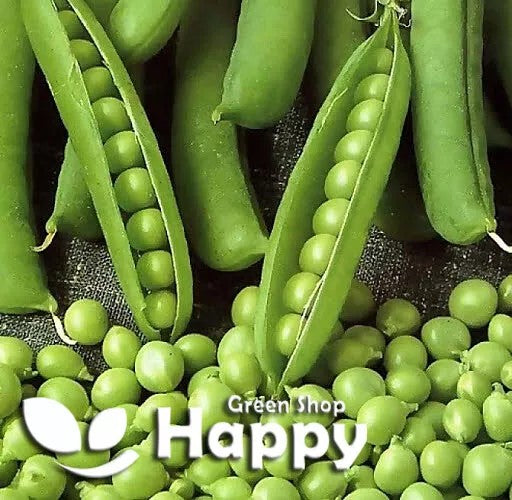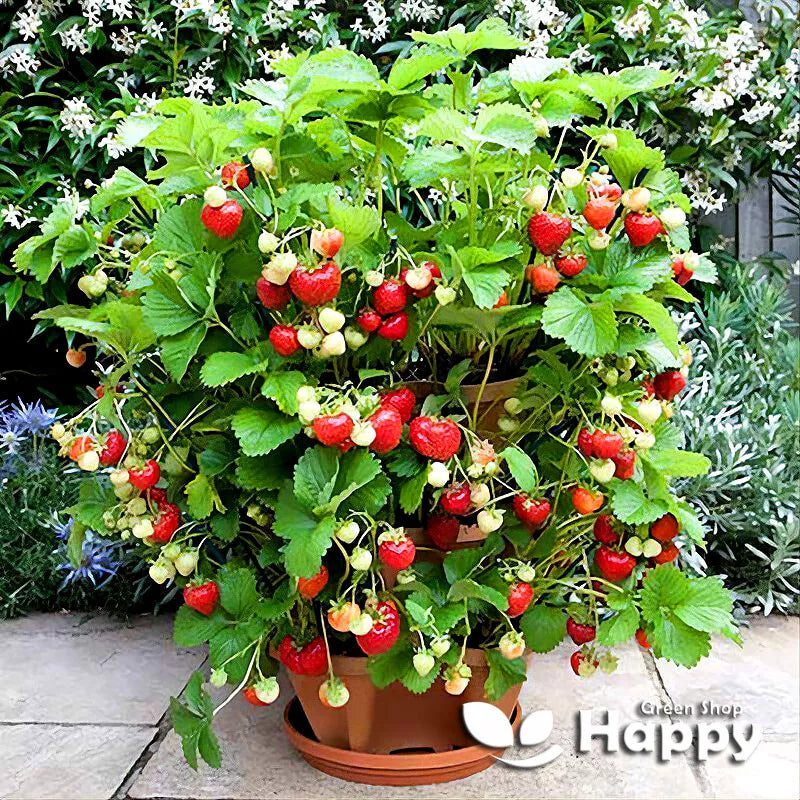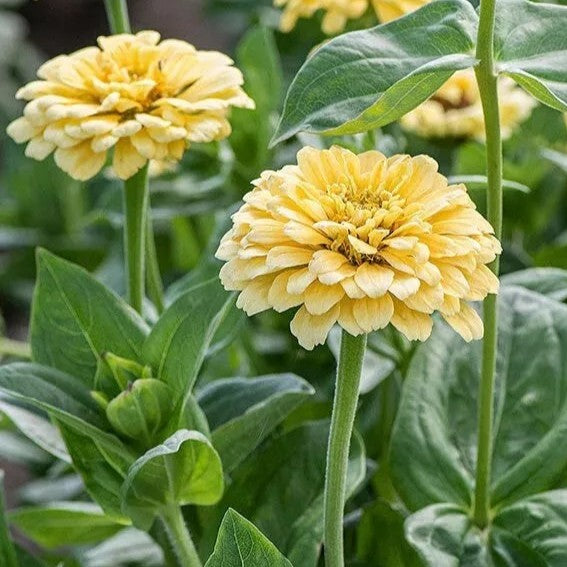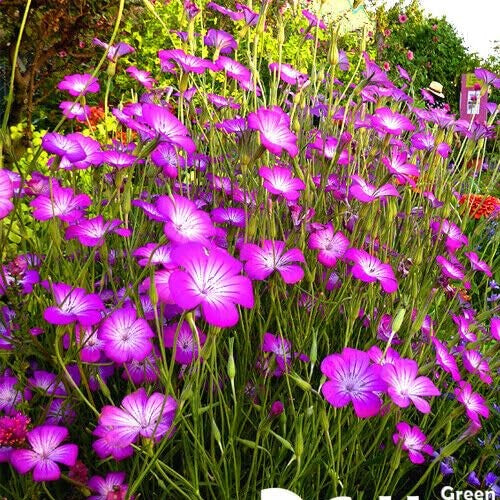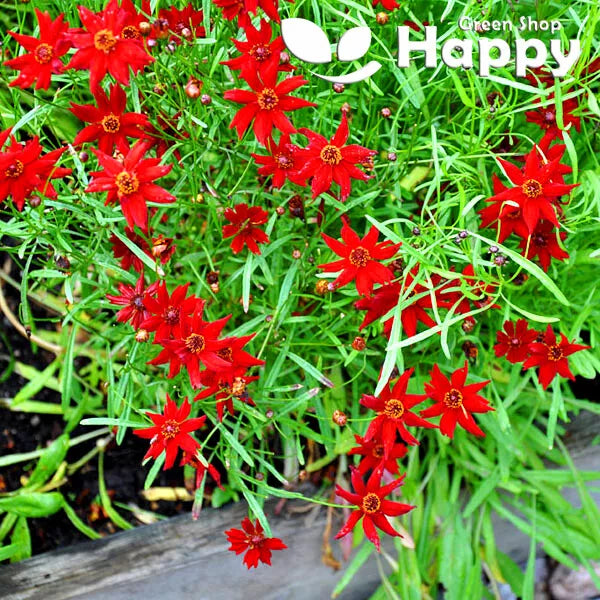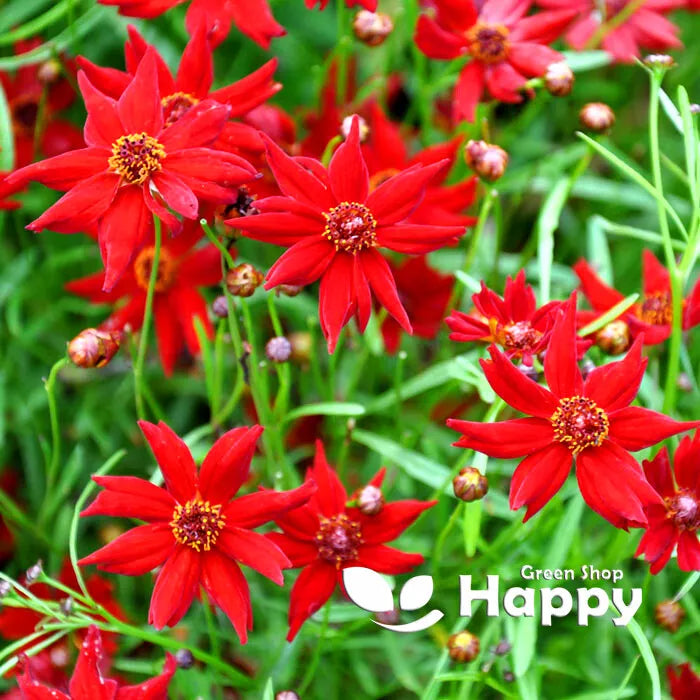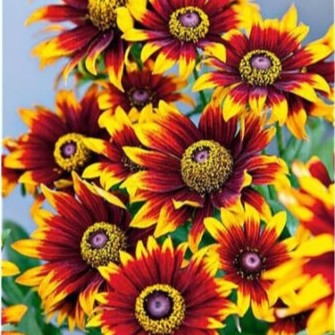Sort by:
326 products
326 products
Cosmos 'Radiance' – Seeds
(Cosmos bipinnatus)
Cosmos 'Radiance' is a charming variety that produces large, daisy-like blooms in deep carmine-pink with a lighter halo around the golden-yellow centers. The graceful, feathery foliage and long, slender stems make it a superb choice for garden displays and cut flowers. Easy to grow and long-flowering, it’s a true summer favourite.
Key Features
-
Type: Half-hardy annual
-
Height: 90–120 cm
-
Spread: 40–50 cm
-
Flowering: June–October
-
Position: Full sun
-
Soil: Well-drained, moderately fertile
Ideal For
-
Cottage gardens
-
Wildlife and pollinator-friendly planting
-
Borders and background planting
-
Cut flower arrangements
Sowing & Growing
-
Sow indoors: March–April at 18–21°C
-
Sow outdoors: May–June directly in final position
-
Germination: 7–10 days
-
Thin/transplant to 30–40 cm spacing
-
Deadhead regularly for prolonged flowering
Cosmos ‘Polidor’ Mix – Seeds (Cosmos sulphureus)
The Cosmos ‘Polidor’ Mix is a dazzling, warm-toned variety producing masses of semi-double blooms in shades of gold, orange, and scarlet-red. Unlike the softer pastel cosmos, this species (Cosmos sulphureus) is more compact, with bushy growth and excellent heat tolerance. Perfect for bright summer borders and butterfly gardens.
Highlights
-
Vivid warm shades: yellow, orange, and red
-
Semi-double flowers with a cheerful, fiery look
-
Excellent for hot, sunny, dry spots
-
Attracts bees, butterflies, and pollinators
Key Features
-
Botanical Name: Cosmos sulphureus
-
Variety: ‘Polidor’ Mix
-
Seed Count: Approx. seeds per pack
-
Height/Spread: 60–90 cm tall, 30–45 cm spread
-
Position: Full sun, well-drained soil
-
Flowering Period: July–October
Perfect For
-
Adding vibrant warm tones to garden beds
-
Containers, borders, and cutting gardens
-
Low-maintenance summer displays
-
Pollinator-friendly plantings
Sowing Instructions
-
Sow indoors March–April at 18–21°C
-
Cover seeds lightly with compost
-
Germination: 7–14 days
-
Harden off and transplant outdoors after frost, spacing 25–30 cm apart
-
Can also be direct sown outdoors May–June
Cosmos ‘Candy Stripe’ – Seeds
(Cosmos bipinnatus)
Cosmos ‘Candy Stripe’ is an elegant annual with delicate, bicolor flowers in white with soft pink stripes. Its tall, airy stems make it perfect for borders, wildflower meadows, and cut flowers. Easy to grow, long-flowering, and attractive to pollinators, it adds a charming, whimsical touch to any garden.
Why Grow Cosmos ‘Candy Stripe’?
-
White flowers with soft pink stripes
-
Tall, airy stems
-
Long-flowering and easy to grow
-
Attracts bees, butterflies, and pollinators
Key Features
-
Type: Annual
-
Height: 100–150 cm
-
Flowers: Summer to autumn
-
Position: Full sun
-
Soil: Well-drained, moderately fertile
Ideal For
-
Borders, wildflower gardens, and meadows
-
Cut flowers and floral arrangements
-
Pollinator-friendly gardens
-
Low-maintenance colorful displays
Sowing & Growing
-
Sow indoors: February–April in seed trays
-
Sow outdoors: April–May in prepared soil
-
Germination: 7–14 days at 18–22°C
-
Spacing: 25–30 cm apart
-
Care: Moderate watering; remove weeds and deadhead for continuous blooms
Cornflower Sweet Sultan Yellow – Seeds
(Centaurea imperialis)
Cornflower Sweet Sultan Yellow is an elegant annual with bright, golden-yellow, pompom-like blooms atop sturdy stems. Its long-flowering habit and compact form make it ideal for borders, cottage gardens, and cut flower arrangements. Easy to grow and low-maintenance, it also attracts pollinators like bees and butterflies.
Why Grow Cornflower Sweet Sultan Yellow?
-
Bright yellow pompom-like blooms
-
Compact, long-flowering annual
-
Excellent for borders and cut flowers
-
Attracts bees and butterflies
Key Features
-
Type: Annual
-
Height: 40–60 cm
-
Flowers: Summer
-
Position: Full sun
-
Soil: Well-drained, moderately fertile
Ideal For
-
Borders, rockeries, and cottage gardens
-
Cutting gardens and floral arrangements
-
Pollinator-friendly gardens
-
Container planting
Sowing & Growing
-
Sow indoors: February–April in seed trays
-
Sow outdoors: April–May directly in prepared soil
-
Germination: 10–20 days at 18–20°C
-
Spacing: 20–25 cm apart
-
Care: Water moderately and deadhead to encourage continuous flowering
Cornflower Double ‘Black Ball’ – Seeds
(Centaurea cyanus)
Cornflower Double ‘Black Ball’ is an annual with striking, deep black double blooms that add bold contrast to gardens and floral arrangements. Its long flowering season and compact growth make it ideal for borders, cottage gardens, and pollinator-friendly plantings. Easy to grow and low-maintenance, it also attracts bees and butterflies.
Why Grow Cornflower Double ‘Black Ball’?
-
Striking deep black double blooms
-
Long-flowering, compact annual
-
Attracts bees and butterflies
-
Ideal for borders and cut flowers
Key Features
-
Type: Annual
-
Height: 40–50 cm
-
Flowers: Summer
-
Position: Full sun
-
Soil: Well-drained, moderately fertile
Ideal For
-
Borders, cottage gardens, and mixed beds
-
Pollinator-friendly gardens
-
Cutting for floral arrangements
-
Adding bold, dark contrast to plantings
Sowing & Growing
-
Sow indoors: February–April in seed trays
-
Sow outdoors: April–May directly in prepared soil
-
Germination: 10–20 days at 18–20°C
-
Spacing: 20–25 cm apart
-
Care: Moderate watering; deadhead to prolong flowering
Corn Cockle – Seeds (Agrostemma githago)
Corn Cockle (Agrostemma githago) is a classic wildflower that brings simple charm to any garden. Its tall stems carry graceful, cup-shaped magenta-pink blooms that sway beautifully in the breeze. Once common in cornfields, this heritage flower is now treasured for wildflower meadows, cottage gardens, and naturalistic plantings. Easy to grow and loved by pollinators, it thrives in sunny, well-drained soil.
Why Grow "Corn Cockle"
-
Bright magenta-pink wildflower blooms
-
Tall, graceful stems for naturalistic planting
-
Heritage flower once common in fields
-
Attracts bees and pollinators
Key Features
-
Type: Hardy annual (Agrostemma githago)
-
Height: 60–90 cm
-
Flowering: June–September
-
Position: Full sun
-
Uses: Wildflower meadows, borders, cut flowers
Ideal For
-
Naturalistic and wildlife gardens
-
Wildflower meadows and cottage planting
-
Pollinator-friendly spaces
-
Tall, airy accents in borders
Sowing & Growing
-
Sow outdoors: March–May or August–September
-
Sow direct into prepared soil, lightly cover
-
Germination: 14–21 days
-
Thin seedlings to 25–30 cm apart
-
Prefers full sun and well-drained soil
Coreopsis ‘Amulet Red’ – Seeds
(Coreopsis tinctoria)
Coreopsis ‘Amulet Red’ is a striking annual that produces masses of deep red, daisy-like blooms throughout summer. Its long-lasting flowers attract bees, butterflies, and other pollinators, making it both a decorative and wildlife-friendly choice. Perfect for borders, wildflower gardens, and cutting.
Why Grow Coreopsis ‘Amulet Red’?
-
Abundant deep red daisy-like flowers
-
Long flowering season from summer to autumn
-
Attracts bees, butterflies & pollinators
-
Easy to grow and low-maintenance
Key Features
-
Type: Hardy annual
-
Height: 45–60 cm
-
Flowers: June–October
-
Position: Full sun
-
Soil: Well-drained, moderately fertile
Ideal For
-
Borders and cottage gardens
-
Wildflower-style plantings
-
Pollinator-friendly gardens
-
Cut flower arrangements
Sowing & Growing
-
Sow outdoors: April–May in prepared soil, thin seedlings as needed
-
Sow indoors: March–April in trays, plant out after last frost
-
Germination: 7–14 days at 18–22°C
-
Spacing: 20–25 cm apart
-
Deadhead spent blooms to prolong flowering
Coneflower ‘Green Twister’ – Seeds (Echinacea purpurea)
Description:
Add a striking twist to your garden with Coneflower ‘Green Twister’ (Echinacea purpurea), an extraordinary variety featuring bi-colored petals that blend lime green edges into vivid magenta centers. This hardy perennial blooms from midsummer to autumn, attracting bees, butterflies, and pollinators. Easy to grow and drought-tolerant once established, it’s perfect for borders, wildlife gardens, and long-lasting cut flower displays.
Key Features
-
Unique green and pink bi-colored petals
-
Long-lasting blooms from summer to autumn
-
Hardy perennial and drought-tolerant
-
Excellent cut flower with strong stems
-
Attracts bees, butterflies, and pollinators
Ideal For
-
Cottage and wildlife gardens
-
Flower borders and mixed beds
-
Pollinator-friendly plantings
-
Cut flower arrangements
Sowing & Growing
-
Sow Indoors: February–April
-
Transplant Outdoors: May–June
-
Germination: 14–21 days at 18–22°C
-
Flowering: July–September
-
Height: 70–90 cm
-
Spacing: 30–45 cm apart
-
Light: Full sun
-
Soil: Well-drained, moderately fertile
Care Tips
-
Water young plants regularly until established
-
Deadhead to encourage extended flowering
-
Cut back in autumn for tidy regrowth
-
Drought-tolerant once mature
Coneflower 'Orange Fudge' Seeds (Rudbeckia hirta)
Bring warm, glowing color to your garden with Coneflower 'Orange Fudge'. This striking Rudbeckia variety produces rich orange petals with a warm golden touch and dark contrasting centers. Long-flowering and easy to grow, they add bold charm to borders, wildlife gardens, and cut flower arrangements.
What Makes It Special
-
Unique orange blooms with dark centers
-
Long-lasting flowers from summer to autumn
-
Attracts bees, butterflies, and pollinators
Key Features
-
Botanical name: Rudbeckia hirta
-
Hardy annual / short-lived perennial
-
Height: 50–60 cm
-
Blooming period: July–October
-
Drought-tolerant and low maintenance
Ideal For
-
Cottage and wildlife gardens
-
Borders and mixed beds
-
Summer cut flower bouquets
Sowing
-
Sow indoors from February–April or outdoors from May
-
Lightly cover seeds and keep moist (germination: 14–21 days at 18–22°C)
-
Transplant seedlings after frost into sunny, well-drained soil
-
Flowers in the first season
Showing 252/326

